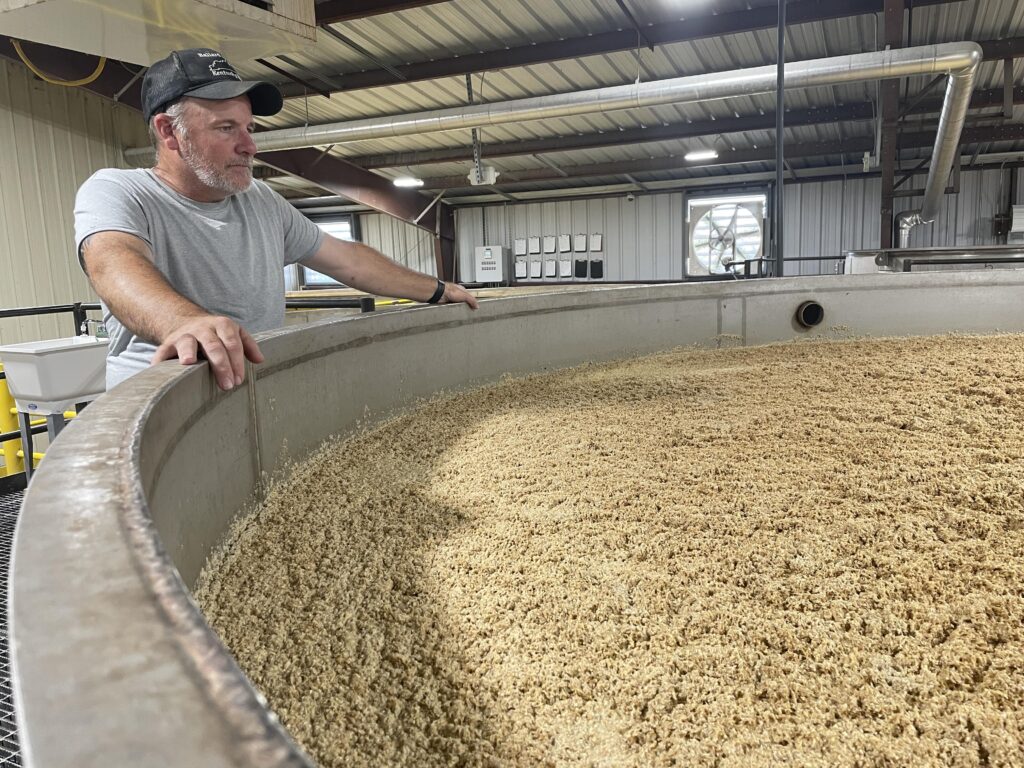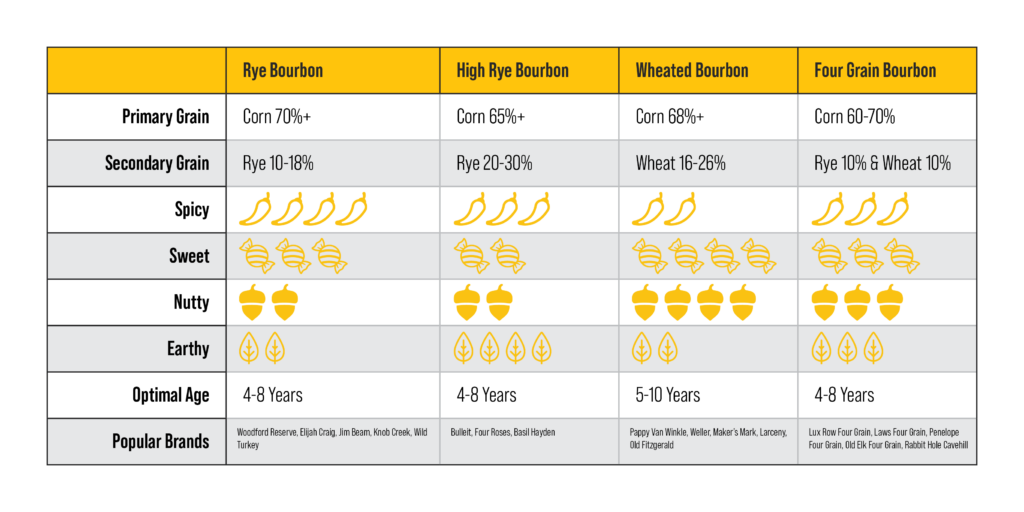
Bourbon Mash Bills: The Grain Recipe Behind Every Sip
When bourbon enthusiasts talk about what gives bourbon its unique flavor, they usually focus on one primary factor: the barrel. Indeed, experts often credit the new, charred oak barrel with around 70% of bourbon’s taste and 100% of its color. But there’s another major component in the way a whiskey tastes — the mash bill. This grain recipe, known as the mash bill, contributes a significant 30% of flavor nuances that make each bourbon unique.
As Kaveh Zamanian, founder of Rabbit Hole Distillery, aptly puts it, “I summarize bourbon, from a making standpoint, as 51% corn and 49% possibility, or 49% opportunity.” For Zamanian and many distillers like him, the mash bill is more than a recipe; it’s a creative foundation. Selecting the grains and deciding on their ratios is similar to a chef choosing ingredients and techniques. From the cooking process to fermentation, every choice shapes the final spirit. Let’s dive into the nuances of that “49% opportunity” and discover how it sets the stage for bourbon’s diverse, complex flavors.
What is a Bourbon Mash Bill?
The mash bill is essentially the grain recipe a distiller chooses for their bourbon or whiskey. To legally be called bourbon, the mash bill must include at least 51% corn. Beyond this requirement, distillers have a fair amount of creative freedom. They can add secondary grains to build a specific flavor profile, texture, and finish. But how does a distiller decide which grains to use and the exact percentages? The short answer: preference.
For instance, do you like your bourbon spicy? Smooth? Rich and sweet? Complex? By choosing certain mash bills, distillers can emphasize these characteristics. Regardless of the grains chosen, one thing is always paramount: quality. As Pam Heilmann, master distiller emerita of Michter’s, once said, “Shit in, shit out.” Quality grain is essential to crafting a quality bourbon, which is why most distilleries use high-tech equipment to verify that every load of corn, rye, wheat, and malted barley meets their standards. The care given to grain selection directly impacts the quality of the finished product.
The Impact of Grain Choice and Quality
Each grain in the mash bill provides a specific flavor and texture. Corn, as the dominant grain, gives bourbon its signature sweetness and mouth-coating richness. Rye brings peppery spice, while wheat contributes a softer, sweeter character. Finally, malted barley aids fermentation by providing essential enzymes for converting starch into sugar, while also imparting subtle toasty, malty flavors.
Distilleries often carefully vet suppliers, testing each batch to ensure it meets their flavor standards. Many distillers even believe the growing region, or terroir, influences grain quality and flavor. The region’s climate, soil, and other conditions all affect how grains develop. For instance, corn from the American Midwest has a different profile from corn grown in other parts of the world. The distillery’s commitment to selecting the right grain and processing it meticulously ultimately influences the complexity of each sip.
Common Bourbon Mash Bills
Most bourbon mash bills use either rye or wheat as the secondary grain after corn. This secondary grain can have a significant impact on flavor, and each choice offers its own unique qualities.
The Standard Mash Bill (Rye as Secondary Grain)
The majority of bourbons today use rye as the secondary grain, offering a spicier, more assertive flavor profile. Rye’s intensity contributes complexity, adding pepper and subtle hints of clove or anise. This mash bill profile is common in many mainstream bourbons, such as Jim Beam, Evan Williams, and Woodford Reserve. Distillers typically use 10-18% rye, although some go higher to create what’s known as a “High Rye” bourbon.
High Rye Bourbons
An emerging favorite, high rye bourbons use more than 20% rye in the mash bill. This bold choice results in a spicier, more complex flavor with earthy or grassy undertones. High rye bourbons are excellent for those who prefer a bit of punch in their bourbon and are often considered bolder, more adventurous options in the whiskey world. Well-known high rye bourbons include Bulleit Bourbon and Four Roses Single Barrel, which have earned a loyal following for their robust spice notes.
Wheated Bourbons
On the other end of the spectrum, wheated bourbons use wheat as the secondary grain, which provides a softer, smoother profile with a hint of sweetness. The result is an easy-to-drink bourbon that appeals to those who prefer subtlety and smoothness. Notable wheated bourbons include iconic brands like Maker’s Mark, Pappy Van Winkle, and W.L. Weller, known for their approachable, mellow qualities that often make them collector’s items.
The Unique World of Four Grain Bourbons
Naturally, when rules are set, distillers are eager to push boundaries. Enter four-grain bourbons, which incorporate corn, rye, wheat, and malted barley. This mash bill presents an intriguing combination of spicy rye and sweet wheat, with malted barley rounding out the profile. Some four-grain bourbons are celebrated for their complex harmony, while others can feel unbalanced, with flavors that don’t quite meld. Major Kentucky distilleries seldom release four-grain bourbons, but craft distillers like Laws, Penelope, and Old Elk have embraced this experimental category, offering unique expressions that stand out for their innovative profiles. Four-grain bourbons have a growing fanbase, especially among those who crave variety.
The Functional Role of Malted Barley in Mash Bills
While corn, rye, and wheat contribute prominent flavors to bourbon, malted barley plays a more behind-the-scenes but critical role in the bourbon-making process. Typically comprising 5-15% of a mash bill, malted barley might seem like a minor ingredient, but it’s essential for fermentation.
The primary purpose of malted barley is to provide the natural enzymes needed to convert starches into fermentable sugars. During the malting process, the barley grain is soaked in water, causing it to germinate. This activates enzymes such as amylase, which break down starches into simpler sugars. Once the barley is dried, these enzymes are preserved, ready to assist in the conversion process when the mash is cooked. Without these enzymes, the fermentation process would be inefficient, leaving too many unfermented starches and resulting in less alcohol.
Additionally, while malted barley’s contribution to flavor may be subtler compared to corn or rye, it imparts a gentle maltiness that can enhance the depth and complexity of the bourbon. Some distillers might experiment with a higher percentage of malted barley, especially in craft distilleries where balancing flavors is as important as optimizing fermentation.
In short, malted barley is like the silent partner in the mash bill, ensuring the mash can ferment effectively while adding a layer of nuanced flavor to the final product. Without this unsung hero, the distinct bourbon profile would be much harder to achieve.
How CaskX Selects Its Mash Bills
CaskX offers a unique opportunity for investors to participate in bourbon selection. When partnering with a distillery, CaskX often has the option to choose the mash bill for the barrels they select, granting investors a stake in the creative process. While this power might be tempting to wield wildly, CaskX often adheres to tried-and-true recipes that distillers use for their flagship brands. This approach ensures that investors receive high-quality, time-tested bourbons.
To further diversify their investors’ portfolios, CaskX selects a variety of mash bills from their partner distilleries, like Kentucky Artisan Distillery and Jackson Purchase. Investors can choose from both rye-based and wheated bourbons, offering them the chance to diversify their holdings by flavor profile. Additionally, CaskX works with Sagamore Spirit in Baltimore, a distillery renowned for its robust rye whiskies. By partnering with these distilleries, CaskX not only provides variety but also connects investors with distilleries known for their craftsmanship and dedication to quality ingredients.
Building a Bourbon Portfolio with Mash Bill Variety
For investors, mash bill variety can be an asset in itself. Diversifying by mash bill isn’t just about flavor; it’s a way to tap into different segments of the market. A high rye bourbon, for instance, might appeal to bourbon purists looking for spice, while a wheated bourbon could attract those seeking a smooth, approachable pour. As craft distillers continue to innovate and expand on traditional mash bills, CaskX’s investors are uniquely positioned to benefit from this evolving landscape. Investing in barrels with a range of mash bills means owning a diverse slice of bourbon history and having access to unique bottles that cater to every palate.
Mash Bill Comparison Chart

The Mashbills Of Popular Bourbons
| Bourbon Brand | Corn (%) | Rye (%) | Wheat (%) | Malted Barley (%) | Mash Bill Type |
| Buffalo Trace | 80 | 10 | 0 | 10 | Low Rye Bourbon |
| Maker’s Mark | 70 | 0 | 16 | 14 | Wheated Bourbon |
| Wild Turkey 101 | 75 | 13 | 0 | 12 | Standard Rye Bourbon |
| Woodford Reserve | 72 | 18 | 0 | 10 | High Rye Bourbon |
| Pappy Van Winkle | 68 | 0 | 20 | 12 | Wheated Bourbon |
| Blanton’s | 75 | 15 | 0 | 10 | Standard Rye Bourbon |
| Four Roses Single Barrel | 60 | 35 | 0 | 5 | High Rye Bourbon |
| Bulleit Bourbon | 68 | 28 | 0 | 4 | High Rye Bourbon |
| Evan Williams | 78 | 10 | 0 | 12 | Low Rye Bourbon |
| W.L. Weller | 70 | 0 | 16 | 14 | Wheated Bourbon |